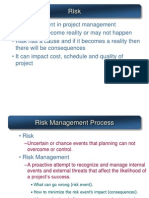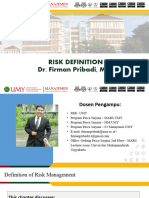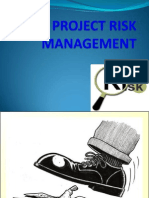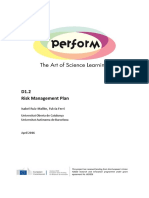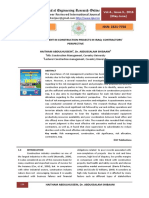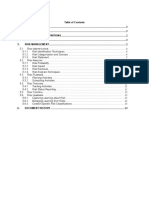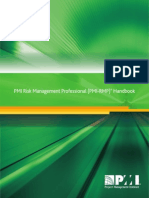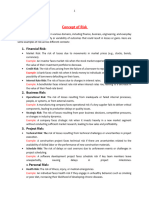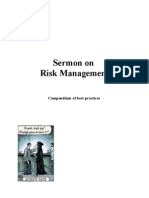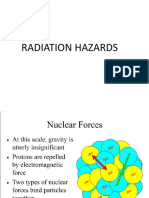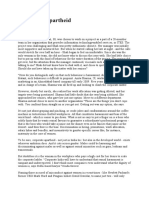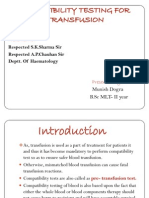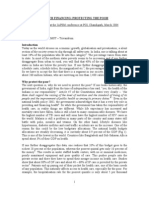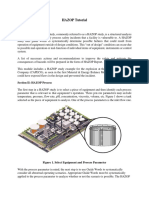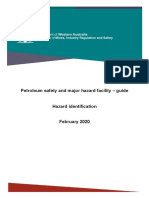Risk Analysis
Faisal I Khan Faculty of Engineering & Applied Science Memorial University
�What may happen
�What may happen
�What may happen
�What Risk Analysis Can Do?
Helps in Forecasting any unwanted situation Estimating damage potential of such situation Decision making to control such situation Evaluating effectiveness of control measures
�Outline of presentation
Definitions of Risk and Hazard Risk Assessment Process Environmental Risk Assessment Industrial Risk Assessment Reliability Risk Assessment Application of Industrial Risk Assessment Application of Environmental Risk Assessment
�Hazard
Hazard: It is a measure of harm/loss or potentiality of an event to cause harm/loss
Fire Hazard Explosion Hazard Toxic Hazard Corrosive Hazard Radioactive Hazards
�Risk
The probability of suffering a harm or loss. It is a combination of hazard and Probability
Risk = Probability of occurrence of hazard X magnitude of hazard
Type of Risks
Background risk Incremental risk Total risk
Measurement of Risk
Individual Risk Societal Risk
�Individual Risk
Risk posed by an individual
It is generally measured in time domain for a particular type of hazard. Risk of Death due to fire in an industry = 1.0E05 /yr
�Societal Risk
Risk for a group of people
It is measured in terms of number of people poses particular risk for a given period of time. Risk of Death to 10 workers due to fire in an industry = 1.0E-09 /yr/10 persons
�Acceptable Risk
Risk thats acceptable to regulatory agency and also to the public Level of Risk of Death Per Year (voluntarily acceptable by public)
Smoking 30 cigarettes per day 1 in 200 Man aged 35-44 1 in 600 Motor Vehicle Accident 1 in 10 000 Accident at home 1 in 12 000 Rail accident 1 in 420 000
�Acceptable Risk Criteria
UK Health and Safety Executive Criteria: FAR (Fatality Accident Rate) Number of fatality in life time working in an industry
FAR = (Number of fatalities)*108/(Total hours worked by all employees during period covered) Acceptable FAR value 1.0
�Acceptable Risk Criteria
US EPA For carcinogens/or other events a lifetime risk of 1 in million (1.0E-06) is defined as acceptable For non-carcinogens a hazard index less than 1.0 is defined acceptable
�Acceptable Risk Criteria
Dutch Acceptable risk criteria
1.0E-05
Frequency of event
Unacceptable region 1.0E-06 Conditional Acceptable 1.0E-08 1.0 100 10 Number of fatalities
�ALARP
As Low As Reasonable Practicable (ALRAP)
1 .0 E-0 1 T he lo w er th e risk le ss p ro p o rtio na tely, it is n e c essa ry to sp e n d to re d uc e it. T his c o n ce p t o f d im in ishing p ro p o rtio n is sh o wn b y th e tria n gle
1 .0 E-0 3 Individual risk (IR)
U n a cc e p ta b l e re g i o n
Th e A L A R P 1 .0 E-0 5 B r o a d l y a c c e p ta bl e re g i o n 1 .0 E-0 7
Tolerable only if risk reduction Is impracticable or cost is grossly disproportionate to the improvement gained
N e g l i g i bl e r i s k
1 .0 E-0 9
�ALARP application
1 .0 E + 0 1 U n it s A f t e r r e m e dia l m e a ur e s U n a cce pta bl e re g i o n 1 .4 E- 0 2 Individual Risk (IR) 1 .0 E - 0 3 3 .7 E- 0 4 A LA R P 1 .0 E - 0 5 2 .3 E- 0 6 5 .2 E- 0 7 1 .0 E - 0 7 B ro a dl y a cce pta bl e re g i o n 1 .0 E - 0 9 Sepa. 1 Sepa. 2 Compr. 1 Compr. 2 Drier Flash N e g l i g i bl e ri s k 5 .5 E- 0 7 5 .2 E- 0 7 1 .2 E- 0 5 1 .2 E- 0 5 4 .2 E- 0 5 1 .2 E- 0 1 1 .2 E- 0 1 B e f o r e r e m e dia l m e a sur e s 5 .7 E- 0 3 1 .0 E - 0 1
Fi g u r e 1 1 . C o m p a r i s i o n o f i n d i vi d u a l r i s k f a c t o r s w i t h A L A R P c r i t e r i a
�Risk Representation
Individual Risk Contour
1.0E-04 2.0E-05 5.0E-06
�Risk Representation
FN curves
Frequency of occurrence (F)
Number of fatalities (N)
�Risk Assessment
Definition and Classification
�Risk Assessment
Risk Assessment is a systematic procedure for describing and quantifying the risk associated with hazardous substance, process, action or event. It involves:
Identification of hazard Quantification of hazard Quantification of probability of occurrence of hazard Estimation of risk
�Classification of Risk Assessment
According to scope of work, risk assessment may be classified as:
Environmental Risk Assessment Industrial Risk Assessment Reliability Risk Assessment Financial Risk Assessment Health Risk Assessment
�Environmental Risk Assessment
Contaminant Risk Assessment
�Environmental Risk Assessment
Risk source Exposure Process Consequenc e process
Release Assessment (Hazard Identification) Exposure Assessment Consequence Assessment (Toxicity Assessment) Risk Estimation (Risk Characterization)
�Environmental Risk Assessment
Hazard identification
Identification of all possible sources of hazards such chemicals, events, etc. Estimate their strength at various mediums Rank them according to their severity Set up priority for the most vulnerable ones
Parameters used for screening and ranking
Concentration Frequency of detection Mobility Persistence in the environment Treat ability
�Environmental Risk Assessment
Exposure Assessment Activities involve in exposure assessment (Benzene)
Release mechanism (volatilization) Transport mechanism (air convection) Transfer mechanism (volatilization) Transformation mechanism (chemical reaction) Exposure point (air) Receptors (population) Exposure Rout (inhalation)
�Environmental Risk Assessment
Exposure Point Concentration: Receptor dose
I = (C*CR*EF*ED)/(BW*AT) Where, I: intake (mg/kg), C: concentration at exposure point (mg/L in water and mg/cu m in air), CR: contact rate (L/day), ED: exposure duration (yr), BW: body weight (kg), AT: Averaging time (days), EF: Frequency of exposure (days/year)
�Exposure pathways
Source
Affected surface soil Wind erosion Atmospheric dispersion Affected subsurface soils Volatilization Accumulation in enclosed space Leaching Affected Groundwater Groundwater transport Inhalation of vapors and/or particulates On-site receptor
Transport Mechanism
Exposure Media
Soil dermal contact and ingestion
Receptors
Groundwater ingestion
Off-site receptor
Surface water, swimming, fish consumption, etc
�Environmental Risk Assessment
Consequence assessment/Toxicity assessment Adverse effect on environment, human or other living system
Response
Dose
�Environmental Risk Assessment
Risk Estimation Carcinogenic risk
Risk = CDI*Slope factor
Non-carcinogenic risk
HI = CDI/RfD HI: Hazard index (dimensionless) CDI: Chronic daily intake (mg/kg-day) RfD: Reference dose (mg/Kg-day)
�Industrial Risk Assessment
Safety Risk Assessment
�Industrial Risk Assessment
Steps involve:
Hazard Identification Hazard Assessment Consequence Analysis Risk Characterization
�Industrial Risk Assessment
Hazard Identification
DOW Indiex Mond Index SWeHI index AHI index
�Industrial Risk Assessment
Hazard Assessment
Qualitative hazard assessment
HAZOP technique OptHAZOP technique
Probabilistic hazard assessment
Fault tree analysis
�Industrial Risk Assessment
HAZOP
HAZOP is a simple structured methodology for hazard identification and assessment, PI&D's, PFD, material flow diagrams, and operating manuals are examined to identify causes and consequences for all possible deviations from normal operation that could arise
�Industrial Risk Assessment
Take one unit or study node at a moment
HAZOP
Keep this unit for conventional HAZOP study
Compare the study node with the unit of Information Base
INFORMATION BASE
No
Is unit matching Yes Apply guide words Analyse the causes and consequences of the deviation drawn from the INFORMATION BASE
Add or remove causes and consequences due to special benaviour of unit
No
Are all deviations over ?
Yes
Are all study nodes over ? Yes Prepare HAZOP report
No
Stop
�Industrial Risk Assessment
HAZOP Report
Project details Study node
Guide word Parameter Causes Consequences Recommendation Rank
�Industrial Risk Assessment
Consequence analysis
Fire modeling Explosion modeling Impact modeling Toxic release and dispersion modeling
�Industrial Risk Assessment
Risk Estimation and Characterization
Individual Risk Societal Risk
�Industrial Risk Assessment
Latest Methodologies WHO methodology
Identification of Hazards
Checklist Matrix diagram of interaction
Assessment of Hazards
Accident sequence analysis Failure effect analysis
Accident Consequence Analysis
�Industrial Risk Assessment
Quantitative Risk Analysis
Hazard identification Frequency estimation Consequence Analysis Measure of Risk
Probabilistic safety analysis
Shown in next slide
�Hazard identification
Identification of plant operating stage Initiating event selection Function system relation Screening of initiating even
Accident sequence modeling
Event sequence modeling System modeling Human performance analysis
Data acquisition and parameter estimation
Initiating events Component failure data Human error probability
Accident sequence quantification
Determination of accident sequence Boolean reduction
Hazardous Substance Release Category Assessment
Outflow model Evaporation model Weather conditions Relation of plant damage state & release category
Consequence assessment
Dispersion models Assessment of doses Dose response models
Integration of results
�ORA procedure
Md leiz t n f c mle ou r a o o p t io e m a eb uis a ga l n n e t p n ino la t t
Hz r i e tfc to aadd ni i ai n * H Aeh iq e I t cn u R
a t d v lo id o e e p ac e t s e aio c id n c n r
a t d v lo id o e e p ac e ts e aio c id n c n r
Qai ai eh z r a s s m t u l t tv aad s e s e n *o t AO po e ue pH Z P r c d r *T P A O t o OH Z Po l
Qa tt tv h z r a s s m t u ni ai e aad s e s e / n Cn e u n ea s s m t osqe c ses e n *M S Co F ea dep s n OE f r ir n x loio s *H Z I f rt x r le s a dd p r io A D o oic e ae n is es n G *D M F C f rc s a in ef cs O I E To a c d g fe t F
P b bi tch z r a s s m t r a i si a ad s e s e o l n *P OA t o R F To l
R ke tm i n i s si a o t
Sp t o
�Description and definition of system Hazard Identification
Accident Modeling
Frequency estimations
Risk Quantification
Risk Documentation & Follow up plan
ORA
Risk management
Probabilistic Safety Analysis Quantitative Risk assessment
Safety Analysis
System Modification to incorporate suggested risk control measures
�Reliability Risk Assessment
Risk Based Maintenance
�Reliability Risk Assessment
Risk Based Maintenance Planning
Risk estimation
Hazard identification Quantitative Hazard Assessment Probabilistic Hazard Assessment Risk Quantification
Risk evaluation
Setting up risk acceptance criteria Risk comparison
Maintenance planning
�What would be the impacts?
Quantitative hazard assessment Accident scenario development
Start
What may go wrong?
How it may go wrong? How likely its occurrence?
What maintenance schedule would reduce its likelihood of occurrence?
Apply maintenance measures and reevaluate risk
Hazard identification
Probabilistic hazard assessment
Fault tree for the envisaged scenario
Fault tree development
Consequences analysis
Fault tree analysis
Risk estimation
Whether risk is in acceptance? Yes End
No Suggest maintenance measures to control risk
�Divide system in manageable units
Consider one unit at a time
Risk Based Maintenance
Risk estimation
Hazard identification/failure scenario development Hazard quantification Probability analysis Risk estimation
Risk Evaluation
Setting up acceptance risk criteria Comparison of assessed risk with acceptance criteria
Maintenance planning
Development of maintenance plan to bring down the unacceptable risk to acceptable level Maintenance scheduling
�Risk Estimation
Start
Consider one unit
Development of accident or failure scenario Quantitative hazard assessment Probabilistic hazard assessment
Estimation of likely damage area
Fault tree development
Consequences assessment Risk estimation
Fault tree analysis
No Are all units over? Yes Move to next module
�Risk Evaluation
Risk factors of another unit Yes Risk factors of another unit
Risk factors of one unit
Comparison of estimated risk against acceptance criteria
Setting up acceptance risk Setting up acceptance risk criteria criteria
Is risk acceptable? No Add this unit for the maintenance planning
No
Are all units over? Yes Move to next module
�Risk factors of one unit
Maintenance planning
Risk factors of another unit
Setup target risk for this unit Conduct reverse fault tree analysis to calculate maintenance duration
No
Are all units over? Yes Re do the fault tree analysis and risk computation of all the units considering maintenance
Setup new target risk
No Is revised risk acceptable? Yes Develop maintenance plan




